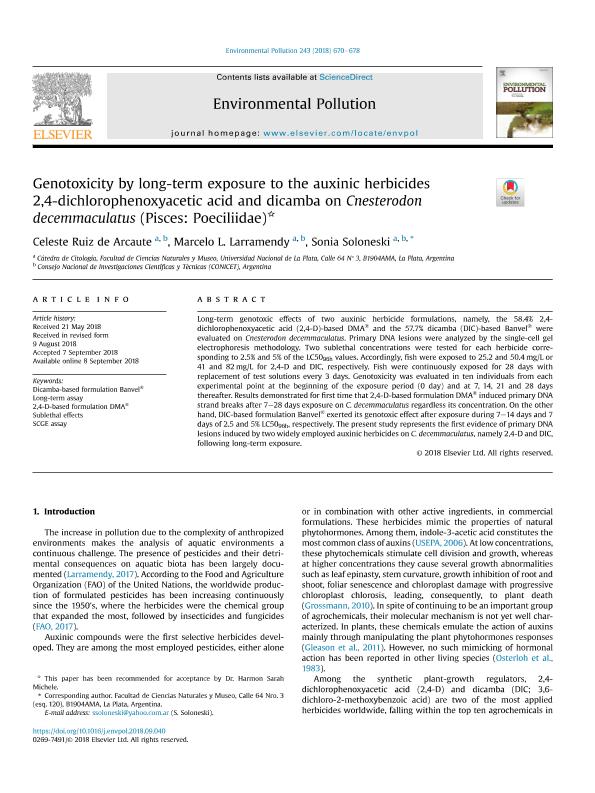Artículo
Genotoxicity by long-term exposure to the auxinic herbicides 2,4-dichlorophenoxyacetic acid and dicamba on Cnesterodon decemmaculatus (Pisces: Poeciliidae)
Fecha de publicación:
12/2018
Editorial:
Elsevier
Revista:
Environmental Pollution
ISSN:
0269-7491
Idioma:
Inglés
Tipo de recurso:
Artículo publicado
Clasificación temática:
Resumen
Long-term genotoxic effects of two auxinic herbicide formulations, namely, the 58.4% 2,4-dichlorophenoxyacetic acid (2,4-D)-based DMA® and the 57.7% dicamba (DIC)-based Banvel® were evaluated on Cnesterodon decemmaculatus. Primary DNA lesions were analyzed by the single-cell gel electrophoresis methodology. Two sublethal concentrations were tested for each herbicide corresponding to 2.5% and 5% of the LC5096h values. Accordingly, fish were exposed to 25.2 and 50.4 mg/L or 41 and 82 mg/L for 2,4-D and DIC, respectively. Fish were continuously exposed for 28 days with replacement of test solutions every 3 days. Genotoxicity was evaluated in ten individuals from each experimental point at the beginning of the exposure period (0 day) and at 7, 14, 21 and 28 days thereafter. Results demonstrated for first time that 2,4-D-based formulation DMA® induced primary DNA strand breaks after 7–28 days exposure on C. decemmaculatus regardless its concentration. On the other hand, DIC-based formulation Banvel® exerted its genotoxic effect after exposure during 7–14 days and 7 days of 2.5 and 5% LC5096h, respectively. The present study represents the first evidence of primary DNA lesions induced by two widely employed auxinic herbicides on C. decemmaculatus, namely 2,4-D and DIC, following long-term exposure. 2,4-D and dicamba exert primary DNA lesions in blood cells of C. decemmaculatus after long-term exposure.
Archivos asociados
Licencia
Identificadores
Colecciones
Articulos(CCT - LA PLATA)
Articulos de CTRO.CIENTIFICO TECNOL.CONICET - LA PLATA
Articulos de CTRO.CIENTIFICO TECNOL.CONICET - LA PLATA
Citación
Ruiz de Arcaute, Celeste; Larramendy, Marcelo Luis; Soloneski, Sonia Maria Elsa; Genotoxicity by long-term exposure to the auxinic herbicides 2,4-dichlorophenoxyacetic acid and dicamba on Cnesterodon decemmaculatus (Pisces: Poeciliidae); Elsevier; Environmental Pollution; 243; Part A; 12-2018; 670-678
Compartir
Altmétricas




